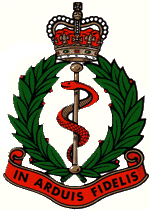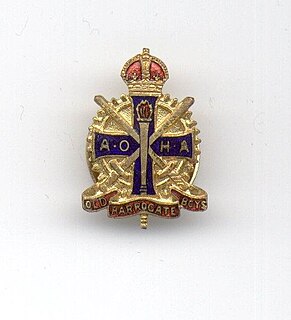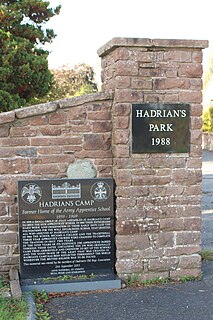Related Research Articles

Ministry of Defence Lyneham or MOD Lyneham is a Ministry of Defence site in Wiltshire, England, about 7 miles (11 km) northeast of Chippenham and 9 miles (14 km) southwest of Swindon. The site houses the Defence School of Electronic and Mechanical Engineering. Also here is Prince Philip Barracks, housing the regimental headquarters of the Royal Electrical and Mechanical Engineers (REME), 8 Training Battalion REME and the REME Museum.

III Corps was an army corps of the British Army formed in both the First World War and the Second World War.

The Corps of Royal Electrical and Mechanical Engineers is a corps of the British Army that maintains the equipment that the Army uses. The corps is described as the "British Army's Professional Engineers".

The Royal Army Medical Corps (RAMC) is a specialist corps in the British Army which provides medical services to all Army personnel and their families, in war and in peace. The RAMC, the Royal Army Veterinary Corps, the Royal Army Dental Corps and Queen Alexandra's Royal Army Nursing Corps form the Army Medical Services.
Historically, an armourer is a person who makes personal armour, especially plate armour. In modern terms, an armourer is a member of a military or police force who works in an armoury and maintains and repairs small arms and weapons systems, with some duties resembling those of a civilian gunsmith. There is increasing evidence that companies specializing in the manufacture of armoured vehicles or applique armour for application onto vehicles of all types are referring to themselves as armourers; such as the UK company OVIK Crossway - which describes its services as Armourers and Coach Builders. In some ways, this is a reversion back to the original meaning of the term insofar as these companies forge, adapt or integrate physical armour onto platforms in order to protect human life.

The Royal Army Service Corps (RASC) was a corps of the British Army responsible for land, coastal and lake transport, air despatch, barracks administration, the Army Fire Service, staffing headquarters' units, supply of food, water, fuel and domestic materials such as clothing, furniture and stationery and the supply of technical and military equipment. In 1965 its functions were divided between other Corps and the RASC ceased to exist; subsequently, in 1993, they in their turn became the "Forming Corps" of the Royal Logistic Corps.

Beachley is a village in Gloucestershire, England, near the border with Monmouthshire. It is located on a peninsula at the confluence of the rivers Wye and Severn, where the Severn Bridge ends and the smaller secondary bridge for the River Wye begins, both bridges carrying the M48 motorway between England and Wales though the motorway is not directly accessible from the village. The tidal range on this stretch of water is the highest in the UK. Before the construction of the bridge it was a ferry port from where the Aust Ferry operated until 1966.The population in 2011 was 764.

The Hong Kong Military Service Corps (HKMSC) was a British army unit and part of the British garrison in Hong Kong. Throughout the history of Hong Kong, it has been the only regular British army unit raised in the territory made up almost entirely of Locally Enlisted Personnel (LEP).

Woolwich Garrison, also referred to as Woolwich Station or Woolwich Barracks, is a garrison of the British Army which forms part of London District. Royal Artillery Barracks, based in the garrison were home to the Royal Artillery until 2007 when their home moved to Larkhill Garrison. At its largest, the garrison oversaw two division headquarters plus supporting units and around 7 battalions.

The Royal Army Ordnance Corps (RAOC) was a corps of the British Army. At its renaming as a Royal Corps in 1918 it was both a supply and repair corps. In the supply area it had responsibility for weapons, armoured vehicles and other military equipment, ammunition and clothing and certain minor functions such as laundry, mobile baths and photography. The RAOC was also responsible for a major element of the repair of Army equipment. In 1942 the latter function was transferred to the Royal Electrical and Mechanical Engineers (REME) and the vehicle storage and spares responsibilities of the Royal Army Service Corps were in turn passed over to the RAOC. The RAOC retained repair responsibilities for ammunition, clothing and certain ranges of general stores. In 1964 the McLeod Reorganisation of Army Logistics resulted in the RAOC absorbing petroleum, rations and accommodation stores functions from the Royal Army Service Corps as well as the Army Fire Service, barrack services, sponsorship of NAAFI (EFI) and the management of staff clerks from the same Corps. On 5 April 1993, the RAOC was one of the corps that amalgamated to form The Royal Logistic Corps (RLC).

The Royal School of Military Engineering (RSME) Group provides a wide range of training for the British Army and Defence. This includes; Combat Engineers, Carpenters, Chartered Engineers, Musicians, Band Masters, Sniffer Dogs, Veterinary Technicians, Ammunition Experts, Bomb Disposal Operators, Counter Chemical Warfare experts as well as Command and Leadership.
An ammunition technician (AT) is a British Army soldier, formerly of the Royal Army Ordnance Corps but since 1993 of the Royal Logistic Corps, trained to inspect, repair, test, store, and modify all ammunition, guided missiles, and explosives used by the British Army. These technicians are also trained to use demolition to safely dispose of individual items of ammunition and explosives (EODs) or to conduct logistics disposal of bulk stocks of multi items. After gaining sufficient experience, those who show the appropriate qualities are given extra training to render safe improvised explosive devices (IEDs) by a process called improvised explosive device disposal. Experienced ATs may be called to give evidence as expert witnesses in criminal or coroner's courts in relation to ammunition or explosives or to EOD and IEDD duties.

The Association of Harrogate Apprentices, whose spiritual home is at Harrogate in England, exists to re-unite people in any way associated with the Army Apprentices School, Harrogate, which was renamed the Army Apprentices College, Harrogate in 1965. This includes people such as ex Apprentice Tradesmen (A/Ts), Permanent Staff Members, ex NAAFI employees, Civilian Instructors etc. who served or worked on the establishment itself in such as the YMCA or Salvation Army canteens.

Arborfield Garrison was a British Army garrison in the English county of Berkshire, approximately 1 mile (1.6 km) south east of the village of Arborfield Cross. The army vacated the site in 2015 and it is now being redeveloped for housing, with a total of 3,500 homes planned. The Garrison and its associated housing estates are split between the civil parishes of Arborfield and Newland and Barkham. Both parishes are within the unitary authority of Wokingham. According to the Post Office the majority of the 2011 Census population was included in the civil parish of Barkham.
The Defence School of Electronic and Mechanical Engineering (DSEME) is one of four Defence Schools within the Defence College of Technical Training (DCTT) of the British Ministry of Defence. It was formed on 1 Apr 2010 and comprises a Headquarters, the British Army's 8 Training Battalion of the Royal Electrical and Mechanical Engineers (REME), and the REME Arms School all based at MOD Lyneham, and the Royal Air Force's No. 4 School of Technical Training at MOD St Athan.

Beachley Barracks is a British Army base at Beachley in Gloucestershire, England, close to the England–Wales border at Chepstow. The Barracks is located at Beachley Point between the River Severn and the River Wye. It is the home of 1st Battalion, The Rifles.

Hilsea Barracks was a military installation at Hilsea in Portsmouth.

The Royal Marine Barracks, Woolwich was a military installation occupied by the Royal Marines and located in Frances Street, just south of Woolwich Dockyard. After the Royal Marines' departure from Woolwich it was renamed Cambridge Barracks, while the adjacent Royal Marine Infirmary was renamed Red Barracks.
This is a list of Meritorious Service Medals (MSM) awarded in the 1918 New Years Honours.

Hadrian's Camp was a military installation on the line of Hadrian's Wall at Houghton in Cumbria, England.
References
- ↑ "Army Apprentices College".
- 1 2 3 Lord, Cliff; Watson, Graham (2003). The Royal Corps of Signals: Unit Histories of the Corps (1920–2001) and its Antecedents. Solihull, W. Midlands: Helion & Co. p. 325.
- 1 2 3 4 "Army Apprentices College, Chepstow - History".
- ↑ Lawson, Lieut.-Colonel G. W. (1934). "What Shall I Do With My Boy?". The King's Royal Rifle Corps Chronicle: 175–177.
- ↑ "AAS history" . Retrieved 16 September 2016.CS1 maint: discouraged parameter (link)
- ↑ "The Army Apprentice". Army Apprentice Memorial. Retrieved 16 September 2016.CS1 maint: discouraged parameter (link)
- ↑ "Apprentice history". Army Apprentice Memorial. Retrieved 16 September 2016.CS1 maint: discouraged parameter (link)
- 1 2 "The History of Junior Training in the RAOC" (PDF). Retrieved 15 September 2020.CS1 maint: discouraged parameter (link)
- ↑ RAPC Apprentice College